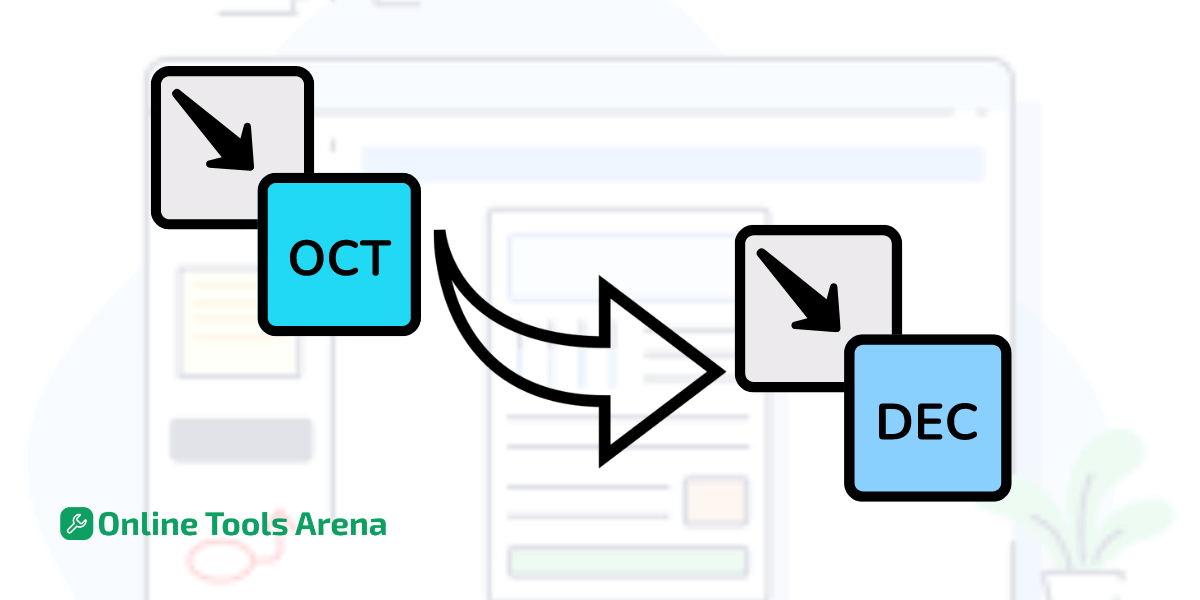
Octal to Decimal
Decimalizing Octal Numbers
Basics of Number Systems
Let's learn the basics of number systems. A number system is a mathematical way of showing numbers using symbols or signs. The most commonly used number systems include:
Decimal System: We use the base-10 system in our everyday life. It has ten numbers (0 to 9), and each place in a number shows what power of 10 it is. For example, in the number 253, '2' means 10 times multiplied by two. The '5’ is ‘times five’, while the three make up a unit of ten itself with no extra any more.
Binary System: The system used a lot in computing, where numbers are shown by only two digits (0 and 1). In a binary number, each spot shows how much 2 is raised to.
Octal System: This is a system that starts at 10 and uses digits from 0 to 7. Every spot in an octal number shows a power of 8.
Hexadecimal System: A counting system that uses numbers 0 to 9 and letters A to F. It is often used in computer science and coding.
What is the Octal System?
The octal system, which means eight in Latin, is a way to count numbers using bases of 8. It utilizes eight different digits: Zero, one, two, three four five six and seven. Unlike the ten digits in the decimal system, the octal system has a smaller way of showing numbers.
What is the Decimal System?
The decimal system, also known as the base-10 system, is the standard system for denoting integer and non-integer numbers. It is the most commonly used number system, consisting of ten digits: 0, 1, 2, 3, 4, 5, 6, 7, 8, and 9. Each digit's position represents a power of 10, with the rightmost digit representing 10010^0, the next representing 10110^1, and so on. This positional notation allows for the efficient representation of large numbers and is the foundation of arithmetic operations such as addition, subtraction, multiplication, and division.

Octal to Decimal Conversion
| Octal | Decimal | Calculation |
|---|---|---|
| 10 | 8 | 1 × 81 + 0 × 80 = 8 |
| 17 | 15 | 1 × 81 + 7 × 80 = 8 + 7 = 15 |
| 25 | 21 | 2 × 81 + 5 × 80 = 16 + 5 = 21 |
| 32 | 26 | 3 × 81 + 2 × 80 = 24 + 2 = 26 |
| 45 | 37 | 4 × 81 + 5 × 80 = 32 + 5 = 37 |
| 70 | 56 | 7 × 81 + 0 × 80 = 56 |
| 100 | 64 | 1 × 82 + 0 × 81 + 0 × 80 = 64 |
| 123 | 83 | 1 × 82 + 2 × 81 + 3 × 80 = 64 + 16 + 3 = 83 |
How To Use Our Octal to Decimal Converter
Input your octal number: Put the octal number you need to change into the required space.
Click "Convert" Once you type the octal number, press the "Convert" button.
View the result: The tool will quickly show the decimal version of your octal number.
Copy or Use the Result: Now you can take the decimal answer and use it for your math or programs.
FAQs
What is an octal number system?
The octal number system is a base-8 numeral system that uses digits 0 to 7. Each digit represents a power of 8, making it distinct from the decimal system, which is base-10. Octal numbers are commonly used in computer science and digital electronics due to their straightforward representation of binary numbers.
How do you convert an octal number to a decimal number?
To convert an octal number to a decimal number, multiply each digit of the octal number by 8 raised to the power of its position (counting from right to left, starting at 0). Then, sum all the results. For example, the octal number 17 converts to a decimal as follows: 1×81+7×80=8+7=151 \times 8^1 + 7 \times 8^0 = 8 + 7 = 15.
What are the uses of the octal number system?
The octal number system is used in computing and digital electronics. It simplifies the representation of binary-coded values, as each octal digit corresponds to three binary digits. This makes it easier to read and understand binary data, particularly in systems where binary digits are grouped in threes.
Can you provide an example of converting an octal number to a decimal number?
Sure! Let's convert the octal number 25 to decimal. Each digit of 25 is multiplied by 8 raised to the power of its position:
2×81+5×80=16+5=212 \times 8^1 + 5 \times 8^0 = 16 + 5 = 21
So, the octal number 25 is 21 in decimal.
Why is the octal system less commonly used today?
The octal system is less commonly used today due to the widespread adoption of the hexadecimal system (base-16), which is more efficient for representing binary data. Hexadecimal digits represent four binary digits each, making it more compact and convenient for modern computing applications.











